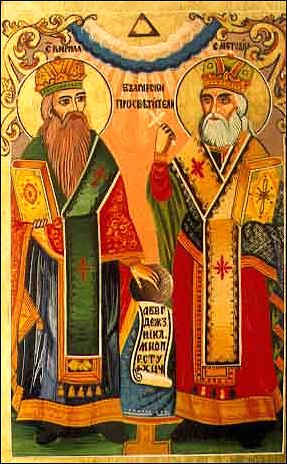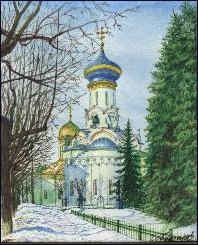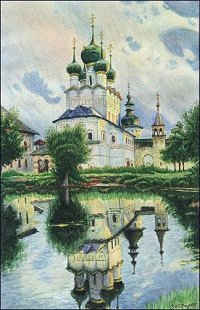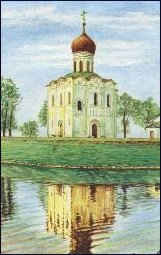
In the 9th century the growing estrangement between the Churches of Rome and Constantinople was reflected in the competition between the two in the endeavor to win over the Slavic peoples and to direct their poltiical and religious development. Occupying lands between the Eastern and the remnants of the Western Roman Empires the Slavs came under increasing pressure from the German princes and their hierarchs to bring them under the influence and control of the latter which contrasted with the efforts of many Slavic princes to escape German control by fostering contact with Constantinople.
Illustrative of this struggle are the missions of Cyril and Methodius, Greek brothers born and brought up in Thessalonica among the Slavs of that region. Saints Cyril and Methodius, the Apostles to the Slavs, (feastday in the Eastern Church - May 11; in the Western Church - July 7) as they were later known, were articulate in the Slavonic language, studied in Constantinople and chose the monastic life. When the princes of Bohemia and Moravia sought the help of the Byzantine Emperor, Michael III, to evade German designs on them, the Emperor sent Cyril and Methodius. In anticipation of their mission among the Slavs, the brothers had translated the Greek service books into Slavonic, developing a form of script known as Glagolithic which was later modified into Cyrllic by one of Cyril's disciples. The brothers were well received in Bohemia and Moravia because, unlike the German missionaries, they preached and worshiped in Slavonic which was intelligible to the population. Their success among the Slavs aroused the animosity of the Germans who demanded that the Apostles to the Slavs adhere to the Latin language in the celebration of the liturgy as was universally the practice of the Roman Church
The brothers travelled to Rome to seek the approval of the Roman pontiff, Hadrian II. The Pope approved the use of the Slavonic liturgy, consecrated the brothers as bishops and designated Methodius as archbishop of Pannonia and papal legate to the Slavic nations. In 869 Cyril died and was buried in Rome. When Methodius returned to his see, he found that the Germans were firmly in control. He was imprisoned for two years but was released in 872 on the insistance of Pope John VIII. Nevertheless the new pope sided with the Germans and all further appeals were of no avail. Finally in 885 Pope Stephen V capitulated to the wishes of the German hierarchy and abolished the Slavonic liturgy. In the same year Methodius died, having just completed the translation of a portion of the Scriptures into Slavonic. The disciples of Saints Cyril and Methodius went into exile heading southeast where they found refuge and friendly reception among the South Slavs. Thus the work of the Apostles to the Slavs which began with promise within the Patriarchate of Rome was abandoned by Rome thereby conferring upon the Church of Constantinople preeminence in uniting the Southern and Eastern Slavs, not with Rome, but with Constantinople where they remain today. In the 10th century the Swedish Varangians as traders and conquerors were penetrating the Eastern Slavic regions along the river systems moving in time as far south as the Black Sea and Constantinople. Important trading centers along the rivers became cities and primcipalities under the dominion of the Varangians. Chief among these cities was Kiev on the Dnieper River in the area now known as Ukraine but then called Rus, a name of unknown origin. Trade between the Varangians and the Greeks exposed the former to Greek culture and religion. In time many among the upper classes in Kiev adopted Christianity. In 988 Grand Duke Vladimir of Kiev, a slavized Varangian, wishing political association with Constantinople, requested of the Emperor the hand of his sister, which was granted upon the condition that he accept Christianity. He agreed, was baptized and in his zeal for the new religion he led his warriors and people down to the Dnieper where they accepted the waters of salvation at the hands of Greek bishops and priests, albeit under some duress for many. Therewith began his effort to eradicate paganism among the Eastern Slavs and to introduce Christianity among the many dependant principalities of Rus. Vladimir, whom we now know as St. Vladimir the Great, Equal to the Apostles (feastday - July 15) died in 1015 after a penitent and edifying life.
In the days of St. Vladimir the Great, baptism was merely the beginning of conversion, not the end result, for it took many generations, if not centuries before the old heathenish beliefs and practices of the Eastern Slavs were rooted out. For the first two hundred years of Kievan Rus, the metropolitans of Kiev were Greeks chosen by the Patriarch of Constantinople. Slowly during that period Greek monks penetrated far and wide in the lands of Rus to build churches and monasteries and to carry True Glory's saving creeds into the far reaches of a vast realm. Many pagan beliefs and customs were slow to yield to the new faith and persisted into modern times. In the struggle, however, Christianity enjoyed several advantages which ultimately prevailed. First it was the state religion enjoying the benign protection of the princes of Rus, and it was supported by a written language and texts and by a hierarchically organized clergy better suited for the propagation of the faith. Paganism, on the other hand, was condemned; it had neither writing and texts, nor doctrines and standards of ethical or moral conduct, nor a priesthood charged with the custody of the religion. Slowly it yielded and eventually the Eastern Slavs came to adhere to the new religion with even more tenacity than to the old. The old ways persisted in outlying places throughout Rus but slowly retreated into a chimera of folk legends, verses and curses, and customs, some pious and others not, which were no longer regarded as a threat to the orthodox faith but continued nevertheless to enrich the folklore and imagination of the people.
Saint Vladimir the Great
Return
to Index. |




